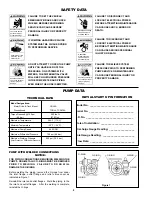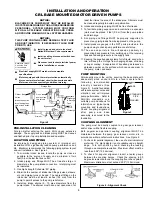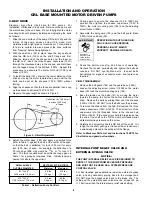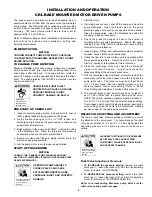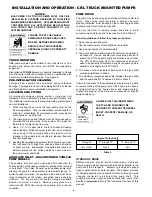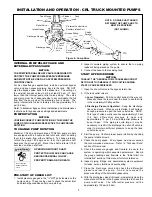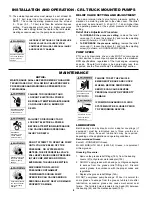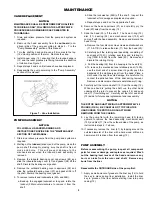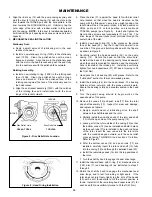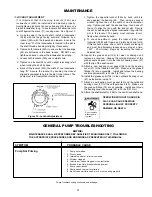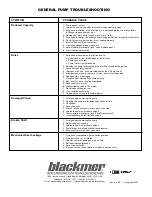
8
FAILURE TO SET THE VEHICLE
EMERGENCY BRAKE AND CHOCK
WHEELS BEFORE PERFORMING
SERVICE CAN CAUSE SEVERE
PERSONAL INJURY OR PROPERTY
DAMAGE.
Hazardous machinery
can cause severe
personal injury or
property damage.
Hazardous or toxic
fluids can cause
serious injury.
IF PUMPING HAZARDOUS FLUIDS
SYSTEM MUST BE FLUSHED PRIOR
TO PERFORMING SERVICE.
NOTICE:
MAINTENANCE SHALL BE PERFORMED BY QUALIFIED
TECHNICIANS ONLY, FOLLOWING THE APPROPRIATE
PROCEDURES AND WARNINGS AS PRESENTED IN
THIS MANUAL.
INSTALLATION AND OPERATION - CRL TRUCK MOUNTED PUMPS
MAINTENANCE
Hazardous
machinery can
cause serious
personal injury.
FAILURE TO DISCONNECT AND
LOCKOUT ELECTRICAL POWER
BEFORE ATTEMPTING MAINTENANCE
CAN CAUSE SERIOUS PERSONAL
INJURY OR DEATH.
DO NOT ATTEMPT TO OPEN THE PUMP
UNTIL YOU HAVE BLED OFF THE
PRESSURE. ON SYSTEMS WITH
METERS, THE DIFFERENTIAL VALVE
WILL KEEP LIQUID UNDER PRESSURE
IN THE PUMP, METER AND PIPING
EVEN WHEN THE HOSE IS EMPTIED.
Hazardous pressure
can cause personal
injury or property
damage.
FAILURE TO DISCONNECT AND
LOCKOUT ELECTRICAL POWER
BEFORE ATTEMPTING MAINTENANCE
CAN CAUSE SHOCK, BURNS OR
DEATH.
Hazardous voltage.
Can shock, burn
or cause death.
10. The external bypass valve must always be set at least 25
psi (1.7 bar) lower than the internal pump relief valve.
NOTE: The normal operating pressure must be at least
5 - 15 psi (0.3 - 1.0 bar) less than the external bypass
setting. Pump speeds which result in higher pressures
(near the valve setting) forces the liquid to be recirculated,
creating excessive wear on the pump and equipment.
RELIEF VALVE SETTING AND ADJUSTMENT
The pump internal relief valve factory pressure setting is
marked on a metal tag attached to the valve cover. The relief
valve must be set at least 10 - 20 psi (0.7 -1.4 bar) higher than
the operating pressure or the system pressure control valve
setting.
Relief Valve Adjustment Procedure:
1.
To INCREASE the pressure setting
, remove the relief
valve cap (1), loosen the locknut (3), and turn the adjusting
screw (2) inward, or CLOCKWISE.
2.
To DECREASE the pressure setting
, remove the relief
valve cap (1), loosen the locknut (3), and turn the adjusting
screw (2) outward, or COUNTERCLOCKWISE.
PUMP SPEED
PTO and hydraulically driven units MUST contain speed
control devices to prevent pump speeds above the maximum
RPM specifications, regardless of the truck engine unloading
speeds. Should fluid delivery be appreciably less than
expected, see the "General Pump Troubleshooting" section.
DISCONNECTING FLUID OR
PRESSURE CONTAINMENT
COMPONENTS DURING PUMP
OPERATION CAN CAUSE SERIOUS
PERSONAL INJURY, DEATH OR MAJOR
PROPERTY DAMAGE.
Hazardous pressure
can cause personal
injury or property
damage.
LUBRICATION
Ball bearings and hydraulic motor adapter couplings (if
equipped) must be lubricated every three months at a
minimum. More frequent lubrication may be required,
depending on the application and operating conditions.
Recommended Grease:
Exxon® - RONNEX MP Grease;
Mobil®
MOBILITH AW-2 (64353-6) Grease, or equivalent
Lithium grease.
Greasing Procedure:
1. Remove the grease relief fittings (76A) from the bearing
covers (27) or hydraulic motor adapter (135).
2. SLOWLY apply grease with a hand gun until grease begins
to escape from the grease relief fitting port. Discard
excess grease in accordance with the proper codes and
regulations.
3. Replace the grease relief fittings (76A).
DO NOT overgrease pump bearings. While it is normal for
some grease to escape from the grease tell-tale hole after
lubrication, excessive grease can cause mechanical seal
failure. The tell-tale hole is located in the head (20) between
the bearing (24) and the mechanical seal (153).
I
NCORRECT SETTINGS OF THE PRESSURE
RELIEF VALVE CAN CAUSE SYSTEM
COMPONENT FAILURE, PERSONAL INJURY
AND PROPERTY DAMAGE.
Hazardous pressure
can cause personal
injury or property
damage.


